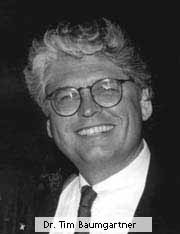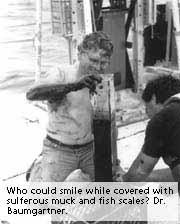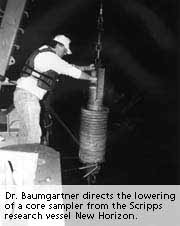






Oceanographer works for scale
by Lori Saldaña

 r. Tim Baumgartner gets excited about sardines,
and not because they're his favorite food.
r. Tim Baumgartner gets excited about sardines,
and not because they're his favorite food.
For the past 15 years, he has collected and examined layers of ocean sediments
that contain well-preserved fish scales, studying historic fluctuations
in populations of sardines and other pelagic (i.e., mid-ocean) fish. And,
like the fish he studies, he migrates, working in Mexico at the Centro de
Investigacion Cientifica y Educacion Superior de Ensenada and at Scripps
Institution of Oceanography in La Jolla.
 His research started as an extension of work pioneered
by Andy Soutar and John Isaacs in the 1970s. He has helped establish proxy
records dating back 2,000 years, providing valuable information about the
relationships between global climate changes, fish populations and ocean
ecology. This information is being used to help manage commercial fisheries
more efficiently.
His research started as an extension of work pioneered
by Andy Soutar and John Isaacs in the 1970s. He has helped establish proxy
records dating back 2,000 years, providing valuable information about the
relationships between global climate changes, fish populations and ocean
ecology. This information is being used to help manage commercial fisheries
more efficiently.
 The path to Mexico
The path to Mexico
 Tim didn't set out to become an international authority
on the history of climate change and its impact on small fish. After receiving
his Master's degree in marine geology from Oregon State University he headed
south to Baja California, Mexico, to accept an invitation to help create
a new department at a marine sciences school in Ensenada. He's been there
since, even while earning his doctorate in Oceanography from Oregon State
University (in 1987).
Tim didn't set out to become an international authority
on the history of climate change and its impact on small fish. After receiving
his Master's degree in marine geology from Oregon State University he headed
south to Baja California, Mexico, to accept an invitation to help create
a new department at a marine sciences school in Ensenada. He's been there
since, even while earning his doctorate in Oceanography from Oregon State
University (in 1987).
 Looking back on this move, he recalls, "In countries
like Mexico, there was a great need for people with higher education. I
just felt like the impact I could make was going to be much greater."
Looking back on this move, he recalls, "In countries
like Mexico, there was a great need for people with higher education. I
just felt like the impact I could make was going to be much greater."
Today, he is making an impact on both sides of the border. His 1992 paper,
Reconstruction of the History of Pacific Sardine and Northern Anchovy Populations
over the Past Two Millennia from Sediments of the Santa Barbara Basin, California
(coauthored by Andy Soutar and Vicente Ferreira) was cited in a letter to
the editors of the prestigious Science magazine. The letter's four authors
- all directors of various fisheries and research programs - noted that
"small pelagics fluctuate massively through time . . . [these] fisheries
pose complex problems of prediction, - problems which Tim's work is helping
them understand.
 He knew almost no Spanish when he moved south. However,
after living nearly 20 years in Baja California, he now is fluent. In August
he gave a presentation in Spanish at a climate change conference in Uruguay,
and another American participant asked him, "Exactly what is your native
tongue?" For the first time, he began to feel that he really belonged
south of the border.
He knew almost no Spanish when he moved south. However,
after living nearly 20 years in Baja California, he now is fluent. In August
he gave a presentation in Spanish at a climate change conference in Uruguay,
and another American participant asked him, "Exactly what is your native
tongue?" For the first time, he began to feel that he really belonged
south of the border.
"I wanted to learn more about Latin America since I had gone on a cruise
to the South Pacific [in 1974], and had spent some time up in the Andes,"
he recalled recently. "I had become fascinated with the culture, and
I wanted to get a job in Peru when I was told of this job in Mexico, teaching
and developing the Department of Marine Geology at the School of Marine
Science in Ensenada."
Looking ahead
 Earlier this year he assembled a group of fisheries
experts near Rosarito, Mexico, as part of a "Bi-National Workshop on
Shared Pelagic Resources Across the U.S.- Mexican Border." The workshop
went well, and he has been invited by the National Oceanic and Atmospheric
Association to coordinate a meeting on climate change research in 1994.
Earlier this year he assembled a group of fisheries
experts near Rosarito, Mexico, as part of a "Bi-National Workshop on
Shared Pelagic Resources Across the U.S.- Mexican Border." The workshop
went well, and he has been invited by the National Oceanic and Atmospheric
Association to coordinate a meeting on climate change research in 1994.
 As for what the future may hold - he just returned from
southern Chile, where his proposal to look for sardine scales in the glacier
fjords was met with enthusiasm by Chilean researchers. "I wish I could
clone myself, or figure out some other way to continue doing my research
for another 50 years," he says.
As for what the future may hold - he just returned from
southern Chile, where his proposal to look for sardine scales in the glacier
fjords was met with enthusiasm by Chilean researchers. "I wish I could
clone myself, or figure out some other way to continue doing my research
for another 50 years," he says.

Lori Saldaña is a writer, public speaker, and photographer
who specializes in conservation and environmental issues.







 The path to Mexico
The path to Mexico